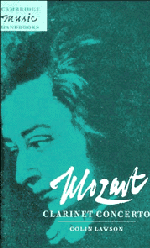Book contents
- Frontmatter
- Contents
- List of illustrations
- Preface
- 1 The eighteenth-century clarinet and its music
- 2 Mozart, Stadler and the clarinet
- 3 The genesis and reception of the Concerto
- 4 Stadler's clarinet and its revival
- 5 Mozart's original text
- 6 Design and structure
- 7 Performance practice
- Appendix 1 A review of the Breitkopf and Härtel edition in the Leipzig Allgemeine Musikalische Zeitung, 4 (March 1802)
- Appendix 2 Surviving instruments
- Appendix 3 A list of works composed by Mozart's clarinettist, Anton Stadler
- Notes
- Select bibliography
- Index
2 - Mozart, Stadler and the clarinet
Published online by Cambridge University Press: 05 June 2012
- Frontmatter
- Contents
- List of illustrations
- Preface
- 1 The eighteenth-century clarinet and its music
- 2 Mozart, Stadler and the clarinet
- 3 The genesis and reception of the Concerto
- 4 Stadler's clarinet and its revival
- 5 Mozart's original text
- 6 Design and structure
- 7 Performance practice
- Appendix 1 A review of the Breitkopf and Härtel edition in the Leipzig Allgemeine Musikalische Zeitung, 4 (March 1802)
- Appendix 2 Surviving instruments
- Appendix 3 A list of works composed by Mozart's clarinettist, Anton Stadler
- Notes
- Select bibliography
- Index
Summary
Introduction: Salzburg
Mozart's early encounters with the clarinet were somewhat fleeting. At least one writer has speculated that he may have heard the instrument as early as 1763 at an ‘academy’ of the Mannheim orchestra in Schwetzingen. As we have noted, he certainly encountered the clarinet during his London visit of 1764, and he first employed the instrument in his own music in the Divertimento K113, written in November 1771 for the private orchestra of a patron in Milan. Generations of scholars have repeated Otto Jahn's assertion that there were no clarinets in Salzburg, but this has recently been called into question by Kurt Birsak. His research uncovered a mention of the clarinet in Salzburg in an Aufsatz und Specification deren Spielleithen nothbetärftigen Instrumenten in französischem Thon (Essay and Specifications of the Instruments in the French Pitch required by Military Bandsmen), dated 1769. Within this document is the entry ‘2 clarinets in D with mouthpiece and long B key as well as a joint for tuning it into C’. In the requests for new instruments, the argument was put forward that, after years of use, they had become ‘gradually unfit for use’, so they must have been employed for some considerable time already. Birsak draws attention to the fact that the public performances of the military bands were still at that time exclusively the duty of the nine professional musicians who formed a band of Musikalischen Parade Instrumente of oboes, horns and bassoons.
- Type
- Chapter
- Information
- Mozart: Clarinet Concerto , pp. 14 - 24Publisher: Cambridge University PressPrint publication year: 1996



